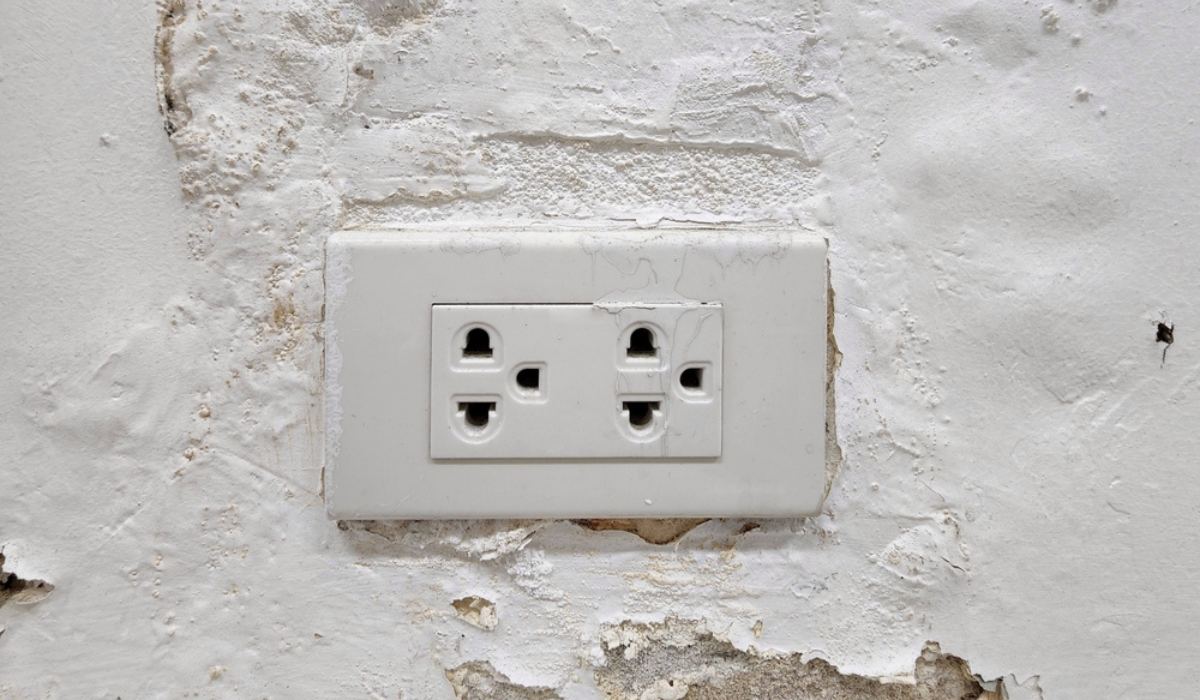One of the serious concerns that home owners battle is water seepage, especially during the monsoons.
The combination of extreme heat and heavy rainfall impacts the strength of a building which shows instances of cracks over time. These cracks if not attended to will eventually lead to water finding its way inside leading to a devastating effect. Also, the older the house, the more prone it is to water seepage. Even in the absence of damp proof course (DPC) and there is no smell of dampness, there is always some moisture that is going to be around, resulting in water seepage issues.
What is water seepage?


Water seepage is water seeping through wall when it rains or water entering the walls because of presence of small holes. This may be because of any breakage or porous materials. Water leakage in wall is one of the most common structural issues, faced by most of the home owners in India.
The damage caused by water seepage is almost irreparable and has to be cured every season through repainting. However, troubles of water seepage in wall could be avoided if proper precautions are taken during the construction. This will not just save a lot of money but will also keep the structural strength of your construction intact. Here is everything you need to know about seepage in wall and ways to stop water leakage from wall in India.
Check out about the roof sheet trends
Difference between leakage and water seepage
Leakage is flowing of fluid or gas from an outlet that is not meant to be- like a cracked wall or a damaged area. Seepage is the way water flows through porous materials.
Water seepage causes

Water seepage may be because of use of inferior raw materials during construction or not taking the water proofing measures seriously during the process of construction. As the external walls of the concrete structure are exposed to the weather, prolonged contact with the rainwater can lead to cracks in the outer covering, giving way to water and moisture seepage in wall. This seepage in wall makes the walls damp. If seepage in wall is not treated in time, this dampness seeps into the interiors, ruining the wall paint.
See also: All about Vinyl flooring sheets

- Musty smell that is unpleasant in nature sets ground work for water seepage.
- Cracks, bubbling, peeling, stains on your walls and warped paints point that your home has too much moisture content and can eventually lead to water seepage.
- Leakage in sewage lines, bathroom, kitchen or the water tank can lead to seepage in wall.
- Leakage in lines which are for water supply, bathroom sanitary fittings and drainage pipes can lead to seepage in wall.
- Water leaking in the bathroom tiles can lead to seepage in wall.
- Faulty plumbing works in a one’s house can lead to severe seepage in wall.

- Absence of plastering in the outer walls of buildings can lead to seepage in wall.
- Ground moisture that rises up leads to seepage in wall and floors.
- The temperature difference between outside air and inside air leads to condensation and thus moisture in walls and windows. This will result in swelling of walls or rotting of structural walls. Also, if moisture affects insulation than it won’t work properly and this will result in heavy electricity bills.
- Absence of drainage pipes leading to water accumulation can on the roof or balcony can lead to seepage in wall.
- Seepage in walls could be due to faulty window frames or liners too. Broken caulking at the window seams, insufficient paint seal along the edges of the glass and cracked putty between panes, can all lead to water trickling and cause seelan or dampness.

See also: Ways to rain-proof your home
Water seepage: Impact on your house

- Water seepage in wall spoils the paints, the wallpapers and even the tiles in severe cases.
- Water leakage from wall spreads to ruin the furniture (wooden especially) is used heavily at home.
- Water seeping through wall when it rains is not good for the longevity of the structure of the house as it eventually impacts the foundation of the house including the iron bars that may start to rust, the bricks may start disintegrating etc.
- Continuous seepage in walls, ceilings and floors may also result in flooding of rooms during heavy rainfall.
Are you aware about the tenant’s right when an apartment is flooded?
Water seepage: Negative impact as per Vastu
- According to Vastu Shastra, water seepage in the kitchen and bathroom signifies financial loss. Water leakage from the wall, broken pipeline, dripping taps, or overhead water tanks within the home, must be treated at the earliest, as they can bring financial loss.
- Damp walls indicate the draining of favourable energy. As per Vastu, leakage or water seepage can also affect spiritual growth. It is believed that continuous leakage from the roof can cause unnecessary clashes between the family members.
- Dampness in the southwest direction of a home is not considered auspicious. So, treat dampness at the earliest, for positive energies and overall well-being.
Impact of water seepage on health
- Water seepage results in risk of mold and mildew which may result in health hazards.
- They may result in becoming breeding ground for microorganisms.
- They can result in respiratory infections like asthama, respiratory disorders etc.
How to detect and treat water seepage in walls?
Note that leakages and seepages have to be treated differently so that the problem is addressed from root level and just not superficially. So, a bathroom wall that is affected will be treated differently from that of an exterior wall of the house.
Housing.com News got in touch with Aarav Master, a Jaipur-based structural engineer, to understand how seepage in wall could be treated.

- Look for water spots-seepage of water on the interior walls of the home.
- Check for the source of water seepage in walls. Seepage of water could be because of leaking water tanks, broken water pipelines or old plumbing issues.
- Ask your structural engineer to check if there is a gap between the walls of your home and the next home, as water seepage in wall is possible through this gap too.
- Another prominent reason for water seepage is the poor quality of materials used for plastering the exteriors. Talk to the contractor or your builder to understand this aspect and the construction quality of your house to prevent seepage in wall.
See also: A guide to buying water tank for house
Interior walls
- Seepage in interior wall begins near the windows or door or the ceiling as these are the places where cracks are seen first.
- Repair the cracks and treat the dampened areas with water proof material and then paint it.
- All the plasters from the areas that are dampened should be removed. These should be treated with mortar or white cement twice and then painted.
- It is a good idea to build cavity walls as they prevent the seepage in wall from exterior wall to interior wall.
- One of the main reasons for seepage of water through to the interiors of your home, is the use of poor quality paint on the walls. These paints allow the moisture to seep through the concrete resulting in seepage in wall and thus damage the walls. Currently, the market is flooded with high-quality paints that are water-resistant and contain elements such as silicon that provide extra strength to areas which are most prone to water seepage.
- Opt for better quality paints after researching and consulting with your structural engineer, to avoid a lifelong hassle of seasonal renovation owing to seepage in wall.
Want to know more about Water conservation at home? Read this guide!
What to do for exterior walls?

Exposure of exterior walls to harsh weather use of poor quality raw materials results in seepage in wall. These can be treated by:
- All the exposed surfaces, such as external walls and boundary walls, should be covered with cement plaster mixed with waterproofing additives, to prevent dampness and seepage in walls.
- Using good quality water resistant paints that have silicon in them.
- You can implement pressure grouts or shot concrete to prevent external wall seepages.
- Process of grunting to be done to waterproof pipes so that they don’t leak.
- Repairing outside cracks immediately with mortar to prevent on manage the seepage in wall.
- You can also use Bitumen membrane, a popular method to damp proof your exterior walls.
How to prevent water seepage through walls if the construction is already done and there are cracks?
- You can use mortar to seal these cracks. It is a dense material which is also waterproof.
- For damaged roof or wall tiles, white cement is the best possible option, as it can prevent chipping of paint in a humid climate.
How to treat ceilings affected by water seepage?

- The primary reason for seepage in wall through ceilings is the accumulation of water on the roof. So treat any crack or blocked pipe in the terrace of the roof to prevent leakage in wall.
- If living in an apartment, a seepage in ceiling may be because of a seepage in bathroom of the residents staying in the house above yours. Get it inspected and treated.
- To prevent seepage on top floors or in independent houses, ensure that the terrace floor has a slope that does not allow water logging after rains or stagnant water due to leaking or overflowing water storage tanks.
- Check the terrace floor and parapet wall of the roof and fill up all the cracks present. Then, paint the parapet wall with waterproof paint.
- A proper waterproofing solution safeguards the home from water leakages and dampness. There are various ways of waterproofing a roof surface. Opt for the best that suits the house construction.
How to treat bathroom leakage?
- Seepage in wall in bathroom can be because of leakage in taps or sanitary fittings. So, mend any leak that exists.
- Also, gaps in the tiles and cracks on the floor or wall can cause leakage and these should be treated with mortar, cement or other water proof materials.
How to treat floor seepage?
- Floor seepage occurs when there is moisture that rises on the ground and spoils the tiles.
- Use water proof materials for repairing the floor and while doing that make sure that there are no gaps between the tiles on the floor.
- During construction, always opt for sturdy water pipes and ensure that the joints are well-sealed. Check for leakages in the water tanks and plumbing every six months and conduct an inspection of the drainage system. You can also hire professionals, who can use proper tools to identify the root cause of the wall water seepage and recommend customised solutions for seepage on wall.
This guide on How to protect the exterior walls of your home during monsoons will prevent your home from seepage. Check out now.
Treatment of seepage before repainting
- Repainting is often considered a solution to get rid of wall seepage. However, repainting does not treat the root cause of the seepage. When the seepage is severe, it causes water to drip from the walls and ceiling. It cannot be fixed with putty and paint only.
- For this, dirt and debris have to be removed, cracks filled and waterproof putties should be applied. New range of paints available today, are resistant to water and contain silicon that offers the walls extra protection against water seepage.
How to prevent water seepage?
- Install drains that will regulate the flow of water and prevent it from accumulating leading to water seepage.
- Check the roof system regularly to see if there are any cracks. If you spot one, mend it immediately.
- Seal the gaps that are seen below doors and windows. This will effectively prevent water seepage.

Source: Pinterest
- Use exhaust fans in the kitchen and bathroom to ensure proper ventilation. Exhaust fans help in removing moisture content from the inside of these rooms thus preventing them from condensing on walls, ceilings etc. causing water seepage in walls. Ensure that the exhaust fans used are of proper size and vented exterior.

Source: Pinterest
- Avoid drying laundry indoors, as it creates a lot of moisture within the home. You can also use dehumidifiers, to remove the moisture from the air thus preventing water seepage in wall.
- Avoid painting the wall during winters, as this can create a lot of dampness inside the walls and result in water seepage in wall. Always opt for painting tasks when you can keep the doors and windows open.

- Always make sure that the steam created inside the kitchen is expelled in the shortest possible time, to avoid dampness on the walls which may result in water seeping through the wall.

- Ensure the window frame inclination enables overflowing rainwater to drain out and not lead to water seepage on the walls. Waterproof the windows before the monsoon. Rubber, foam and vinyl are used as weatherstrips on windows. Choose a material that works best for your window material.

- Keep houseplants like Boston fernsl, peace lily, areca palm and spider plants as they help in removing moisture from the air. These plants reduce humidity and are air purifiers that help to improve indoor air quality.
- Regularly maintain the house to detect water seepage at its inception.
- Invest in good gutter and downspout system.
- You can waterproof the exterior walls to atleast 20 inches.
- Use impermeable films or geotextiles to protect the foundation of the house.
- Use vapour retarder – treated materials such as paints, plastic sheets, foils etc. that will reduce the water vapour. Measure the vapour retarder with Permenance – the lower the value, the better and effective vapour retarder it is. Note that the type of vapour retarder should be chosen based on moisture coming in or out of the house. In case, your house sees moisture traveling both sides, you may avoid the vapor retarder’s use.
Tricks to temporarily conceal water seepage in walls
Seepage in wall makes your house look ugly. If you are working towards treating the water seepage in wall but want to temporarily conceal it so that it doesn’t look ugly, here are some tricks.
1) If there is seepage in wall at the bottom, or lower half of the wall, you can hide it by placing a huge sofa. Be mindful that you don’t place the sofa sticking to the wall and also the material of the sofa is neither wood nor iron as they can get affected by the seepage in wall.
2) If seepage in wall is in the upper half, you can place a wall painting frame to hide it.
3) You can also treat that portion where seepage in wall exists and cover it with wallpaper.
4) Nowadays, vertical gardens are trending and it can also help you to cover the seepage in wall.
5) Hide the place that has been affected by installing a sculpture there which may go beautifully with the theme of your house.
Housing.com POV
Water buildup in your house be however small it is not a good idea. If you ignore it, it may lead to attacking the entire wall that may eventually impact the structure of the building. Presence of harmful mold and mildew will have serious health effects. It’s a good idea to always opt for preventive measures when it comes to wall seepage. Take professional help and inspect regularly and address the wall seepage issue as soon as detected.
FAQs
What causes seepage of water in walls?
Seepage of water could be because of drainage issues, poor construction quality or defective water-proofing material.
Does ventilation prevent seepage in walls?
Ventilation through entry of proper air and light will prevent walls from getting damp and thus growth of moulds.
Is seepage in wall harmful to one’s health and house?
Yes, seepage causes growth of moulds and fungus thus affecting one’s health and these damp walls eventually affect the structure of the building, thus affecting the structural growth of the house.
Can you use paint to prevent wall seepage?
Using high quality paints can prevent wall seepage.
What is the best chemical for wall seepage?
Poly acrylic is the most common waterproofing chemical for concrete structures.
| Got any questions or point of view on our article? We would love to hear from you. Write to our Editor-in-Chief Jhumur Ghosh at [email protected] |

With 16+ years of experience in various sectors, of which more than ten years in real estate, Anuradha Ramamirtham excels in tracking property trends and simplifying housing-related topics such as Rera, housing lottery, etc. Her diverse background includes roles at Times Property, Tech Target India, Indiantelevision.com and ITNation. Anuradha holds a PG Diploma degree in Journalism from KC College and has done BSc (IT) from SIES. In her leisure time, she enjoys singing and travelling.
Email: [email protected]











